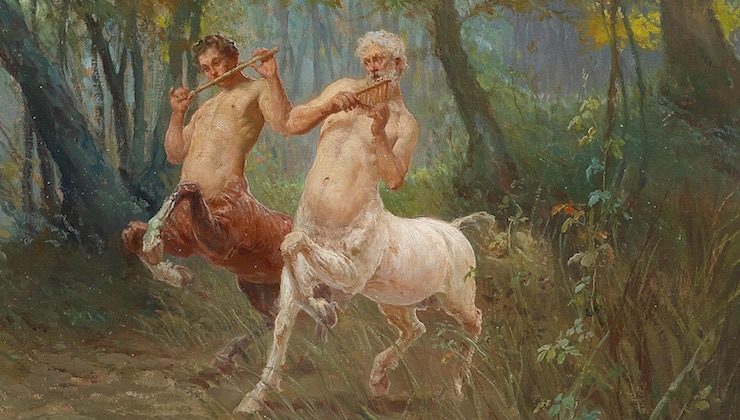This is entirely the fault of the staff writers. I take no responsibility for the consequences. One day I received the following email:
Our staff writers were just debating how centaurs work … and how, for example, they would eat: do they have horse stomachs or human stomachs?
I pondered for exactly three and a half seconds before concluding that that is a very good question. A very good question indeed.
A quick wielding of the google reveals that the subject of centaur anatomy has been much discussed and debated over the centuries. Anatomical drawings and recreations are remarkably numerous; I’m particularly taken with this elegant example. There is even a learned monograph by an eminent pseudoscientist who goes by the handle Univ.-Prof. Dr. Dr. H.C. Reinhard V. Putz, in the Annals of Improbable Research, of course. Nor has Tor.com been absent from the debate. In 2012, Robert Lamb offered a brief disquisition on the subject, essentially quoting Reinhard.
The upshot of all this is that because the Centaur’s delivery system for nutrition is a human or humanoid head and torso—therefore a human-sized jaw, teeth, and esophagus—the Centaur must necessarily live on human food, and its horse stomach will have been modified to accommodate an omnivorous diet. The Greek tradition backs this up, with Centaurs eating bread and meat and drinking wine. There is no way the conventional Centaur can chew grass or hay with a human jaw, let alone consume it in sufficient quantities to support the mass of its body. Just look at what a horse needs to get the job done.
A nice discussion here gets into details and logistics. One commenter notes that the bulk of the horse half would point toward the Centaur having equine-type nutritional needs and the corresponding colic problems: i.e., needing a high-fiber diet, needing to keep moving while it eats, and needing high volumes of water to keep the system in motion. In short, a one-way digestive system, for which stoppages or blockages can be fatal.
As for why this would have to be the case, even if the horse half had a human-style stomach, with the ability to vomit, the small size of the neck and head would make it all too likely the Centaur would drown if its horse-sized stomach tried to back up through its human-sized esophagus.
One way to get around the issue is to size the Centaur down considerably. If the human half is average human size, the equine half would be small-pony-sized or even goat-sized. Not very noble or imposing, but somewhat more logistically possible.
Buy the Book


Across the Green Grass Fields
But really, who wants a six-limbed Satyr when we can have a full-sized Centaur? We can bear in mind that ancient Greek horses were considerably smaller than the modern variety. Probably not as much as the Parthenon friezes might indicate—at least some of that may have been convention, to make humans look bigger and therefore more impressive—but they were still under fifteen hands, and probably well under. Pony-sized, in short.
A well-built pony or small horse can easily carry an adult male, so if the Centaur is fourteen hands or so at what would be his withers (if he didn’t spring up into the human torso), he still has plenty of substance. But then what does he eat? And how does he process it?
If his human segment is essentially a stalk to support the brain, with perhaps a secondary set of heart and lungs to augment the ones in the horse half, and an elongated esophagus leading to the enlarged digestive system in the horse segment, most of the action will happen down in the horse part. If I were designing the organism, I would definitely substitute an omnivore’s stomach and intestines, because the horse version is so prone to failure. So I tend to agree with that line of thought.
The issue of backup and drowning would have to be resolved somehow. Extra stomachs for extra processing, like a bovine? A sphincter down around the area where the navel would be in a human, to void excess gas and liquid? (The logistics of that could get interesting. Centaur wears essentially a sporran, to catch the overflow. Could be developed into elaborate ritual garment with much decoration, and contents would be emptied in privacy, perhaps buried or washed away with appropriate ceremony, like various cultures’ female menstrual traditions.)
Even if the Centaur can function as an omnivore, he’ll still need to consume enough calories to support at least 750 pounds/340 kilograms of muscle and bone. That means he eats constantly, and he eats a lot. He drinks copiously, too—and if he’s Greek, that means barrels of wine. His manure will be… fragrant. Very fragrant. You’ll be able to smell a Centaur encampment from a long ways away, unless the Centaurs are obsessive about sanitation.
There really isn’t a plausible way to keep the horse digestive system intact, because it can’t process the diet that’s coming through the human half, and because there’s no way the human half can chew and swallow multiple pounds of fodder every day. Unless…
A herbivore has to graze constantly in order to support the bulk of its body, because a grass and forage diet while high in fiber is low in calories. An equine also needs to grind the forage thoroughly, and hydrate it well, in order to process it. I’ve noted that human teeth are not adequate for this.
But if the human segment were essentially support for the brain and the first set of heart and lungs—various internet commenters arguing that the human brain is too small to operate the whole body are apparently unaware that a full-sized horse’s brain is the size of a human fist—and the equine segment contains the second and much larger lungs and heart plus the digestive and the reproductive systems, along with additional essential organs including liver and kidneys, there just may be room in the human torso, where the mass of the stomach, intestines, and the liver and lights would normally go, to house an organ unique to the Centaur.
[Editor’s note: Judith’s solution is too horrifying for us to consider further. We’re sorry we asked for this, you’ll have to continue on without us…]
That would be something like an elephant’s trunk, but with an extended jaw and grinding teeth. When not in use it would coil in the human segment’s abdominal cavity. It would extrude through an orifice in the join between the human and horse halves, and hoover along happily while the Centaur thinks great thoughts and instructs its fellow Centaurs and its human students therein.
The trunk has the added virtue of being able to drink as well as eat, so that while the human mouth will do some drinking and a moderate amount of eating—strictly vegetarian, of course, and shading toward vegan—the whole organism receives most of its nutrition through the alternative route. Centaur feasts would extremely interesting proceedings, though in the presence of human guests, the ultra-civilized Centaurs would be careful to restrict themselves to their human eating apparatus.
This might explain both the Greek belief that Centaurs eat like humans, and the Cretan Centaur, which was essentially a human, with human legs, but attached to the hindquarters of a horse. Observers would think that the trunk was a very large reproductive organ, and matrix the forelegs into human legs. But no, the actual Centaur is constructed like a horse in that respect (and if female, that’s a good thing, because Centaur babies would be much too large to emerge through a human birth canal).
All in all, I’d say it’s possible to engineer a Centaur that works, but the straight splicing of human torso on equine body isn’t going to do it. I’m with Team Omnivore and Team Modified Equine Digestive System myself, but if we get to think outside the box, I kind of like the idea of the additional grazing mechanism. Especially if we’re playing with fantasy or science fiction worldbuilding, and designing our own version of the species.
This article was originally published in April 2017 as part of the SFF Equines series.
Judith Tarr is a lifelong horse person. She supports her habit by writing works of fantasy and science fiction as well as historical novels, many of which have been published as ebooks by Book View Cafe. Her most recent short novel, Dragons in the Earth, features a herd of magical horses, and her space opera, Forgotten Suns, features both terrestrial horses and an alien horselike species (and space whales!). She lives near Tucson, Arizona with a herd of Lipizzans, a clowder of cats, and a blue-eyed spirit dog.










